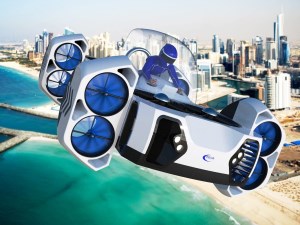The famous Paris Airshow was held last month with the latest aviation and aerospace innovations from around the globe on show.
This year’s show gave visitors plenty to talk about with the unveiling of a new range of personal aircraft – or “flying cars.”
These aircraft are remarkably similar to the flying cars made famous in the 1960s futuristic cartoon series The Jetsons.
Neva Aerospace was one of several companies to reveal plans to build and market passenger carrying flying machines.
This UK-based consortium is made up of five European companies that focus on all sorts of electric aviation, from drones to aerial robotic platforms.
Their latest offering – the AirQuadOne – is ideal for the person who has everything.
Though still in the concept stage, the company has ambitious plans to launch the AirQuadOne within the next five years.
The AirQuadOne uses four electric turbofans, which the consortium members have already proven in unmanned aerial vehicles.
Vertical take-off and landing
It is expected to weigh around 530kg, including 150kg of batteries for the full electrical version and a 100kg for the pilot. Journey times will be up to 30 minutes (depending on mission and load), including vertical take-off and landing. Linear flight will be up to 80 km/h at altitudes of up to 3,000 ft.
Neva is now working with regulators and pilots to seek light aircraft certification within the USA (FAA) and EU (EASA).
The AirQuadOne will have 24/7 traffic management support when flying, with an emergency satcom connection.
Applications for the manned craft may include search & rescue, recreational flying, aerobatics, patrols & defence, transportation, and personal air taxis. Unmanned versions will be able to lift payload up to 100kg and replace cranes and helicopters for delivery to challenging locations.
Uber to launch flying cars in Dubai
Neva expects the battery pack to be similar and/or compatible with those of cars, with recharging at standard electrical stations via direct wire connection, induction or a battery pack switch. Neva is also looking at hybridisation solutions for range extension.
The AirQuadOne is the latest in a long string of "flying car" concepts that, rather suddenly, are being taken seriously by big name, global firms including Airbus and Kitty Hawk and Uber.
In fact, Uber wants to launch flying cars in Dubai in just three years.
And Germany's Lilium is proposing a five-passenger craft with a range of about 320 km and top speed of more than 300 km/h.
But until strict regulations are cemented by authorities globally it’s unlikely these George Jetson flying cars of the future will get off the ground anytime soon.
Aviation experts predict it will take at least five years for the development of practical flying cars.
But don’t expect to have one parked outside your house. It’s unlikely we will see private flying machines whizzing commuters to work in coming years.
A more likely scenario would be personal aircraft used for law enforcement and fire and emergency services to access remote areas.
They may also be employed for workers to reach offshore rigs or for farmers to inspect distant crops.
Whatever the case, we can look forward to some exciting times ahead.


